
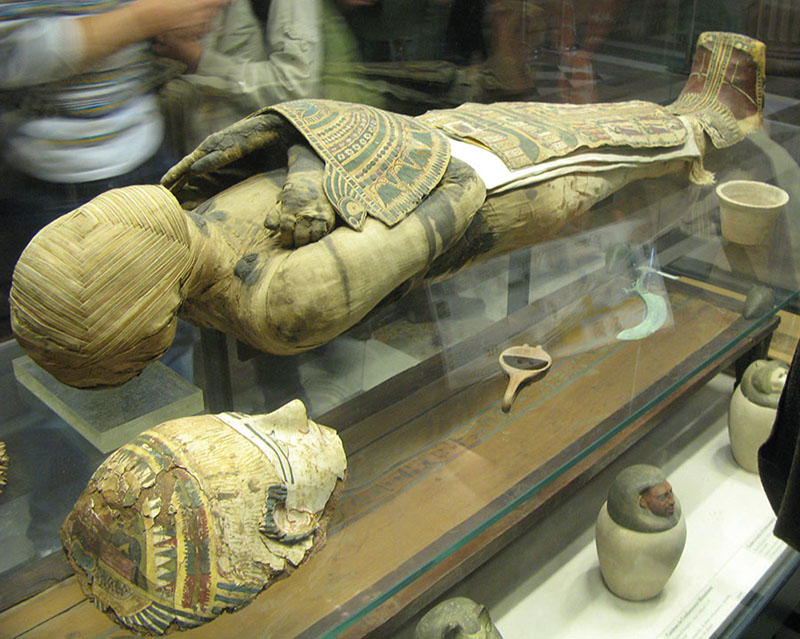


Most often when we think of mummification, what comes to mind is ancient Egypt, especially the times of the Pharaohs. Although mummification existed in other cultures, eternal life was the main focus of all Ancient Egyptians, which meant preserving the body forever. Egyptian culture believed the body was home in the afterlife to a person's Ka and Ba, without which it would be condemned to eternal wandering.
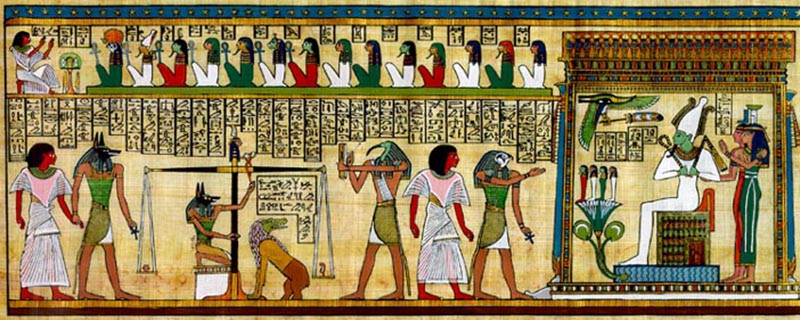
Ancient Egyptian Beliefs in the Afterlife
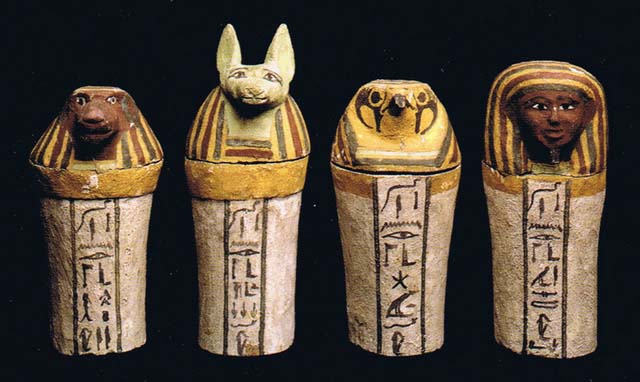
The removed internal organs were separately treated and, during much of Egyptian history, placed in jars of clay or stone. These so-called Canopic Jars were closed with stoppers fashioned in the shape of four heads -- human, baboon, falcon, and jackal - representing the four protective spirits called the Four Sons of Horus.
The heart was removed to be weighed against a feather representing Ma'at to determine moral righteousness. The brain was sucked out of the cranial cavity and thrown away because the Egyptian's thought it was useless. Personal belongings were usually placed in the tomb to make the Ka more at home and to assist the dead in their journey into the afterlife.
Text was read from the Book of the Dead and the ritual of "opening the mouth" was performed before the tomb was sealed.
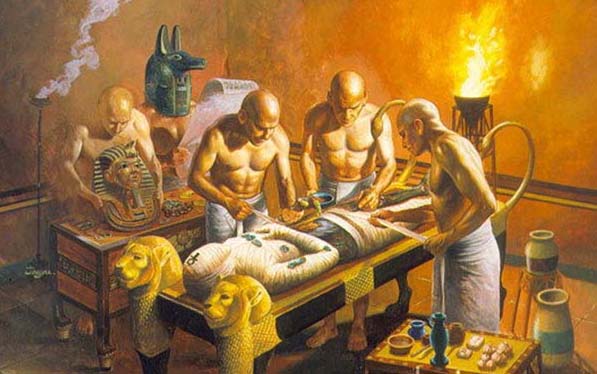
The actual process of embalming as practiced in ancient Egypt was governed by definite religious ritual. A period of seventy days was required for the preparation of the mummy, and each step in the procedure was co-ordinated with relevant priestly ceremonies. The embalmers' shop might be a fixed place, as in the case of those connected with the larger temples. Often, however, it was a movable tent which could be set up near the home of the deceased.
Removal of those parts most subject to putrefaction was the initial step in preparing a corpse for mummification. The embalmers placed the body on a narrow, table-like stand and proceeded to their task. The brain was removed through the nostrils by means of various metal probes and hooks. Such a method necessarily reduced the brain to a fragmentary state, and, as no remains of it are associated with mummies, we may assume that it was discarded. An incision was then made in the left flank of the body to permit removal of the viscera, with the exception of the heart, which was left in the body.
The liver, the lungs, the stomach, and the intestines were each placed in a separate jar, the Canopic Jars, and consigned to the protection of a particular divinity. Next came the preservation of the body itself. This was accomplished in a manner somewhat similar to that of drying fish. But instead of common salt, natron, a mixture of sodium carbonate and sodium bicarbonate, with sodium chloride (common salt) and sodium sulphate as impurities, was used. Natron occurs in Egypt in a few places. Water containing natron in solution comes to the surface and is evaporated, leaving the natron as surface deposits.
Small parcels of natron wrapped in linen were placed inside the body. The outside was covered with loose natron or packages of linen-wrapped natron. The dry atmosphere of Egypt accelerated the desiccation process. After the body moisture had been absorbed by the natron, the packs were removed and the corpse was given a sponge bath with water. The skin was anointed with coniferous resins, and the body cavity was packed with wads of linen soaked in the same material. The body was then ready to be bound into that compact bundle we know as a mummy.
Only linen was used in the wrapping. To give a more natural appearance, linen pads were placed in the hollows caused by the drying. The arms and legs, sometimes even the fingers and toes, were bandaged separately. Then some twenty or more layers of alternating shrouds and bandages were wrapped around the entire body. Between every few layers of linen a coating of resin was applied as a binding agent. The proper wrapping of a mummy required several hundred square yards of linen. The shrouds were sheets six to nine feet square, and the bandages--strips torn from other sheets were from two to eight inches wide and three to twenty feet long. The linen used in wrapping mummies was for the most part not made especially for shrouds but was old household linen saved for this purpose. Often the linen is marked with the name of the former owner, faded from repeated washings. Occasionally bandages bear short religious texts written in ink.
When the wrapping had been completed, the shop was cleaned, and all the embalming materials that had come in contact with the mummy were placed in jars for storage in the tomb. This was a fortunate practice, as Egyptian embalmers were none too careful, and any stray toe or ear which may have become detached or mislaid during the long embalming process was usually swept up with the spilled salt and scraps of linen and included in the storage jars.
But the making of a corpse into a mummy was not all that took place during the seventy days. The artisans who were engaged meanwhile in all the activities essential to proper burial might number in the hundreds. The construction and decoration of the tomb, if not already completed by the deceased during his lifetime, presented an enormous task. Woodworkers were constructing the coffin-or a series of coffins, each to fit within another - tailored to measure.
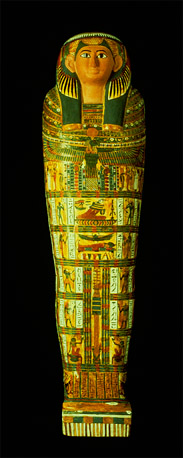
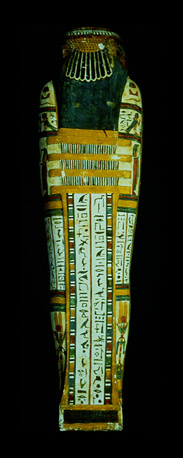
Artists were busy decorating the coffins. The fine painting on the coffins was rarely done directly on the wood, but rather on a smooth plaster coating of whiting and glue over linen glued to the wood. The beautiful colors on many cases are pigments from minerals found in Egypt, often covered with a clear varnish.
Countless other helpers were engaged in constructing and assembling the numerous articles to be deposited with the mummy when it was laid to rest in the tomb.
An extremely important task also undertaken during the seventy days of mummification was the preparation by priests or scribes of magical texts to be placed in the tomb. These texts, now known as the 'Book of the Dead' were written on papyrus rolls varying in length from a few sheets to many sheets, some rolls approaching a length of one hundred feet. Often they were exquisitely illustrated in color. The chapters forming the Book of the Dead contained information necessary to the deceased in overcoming obstacles on his journey and in gaining admittance to the afterworld.
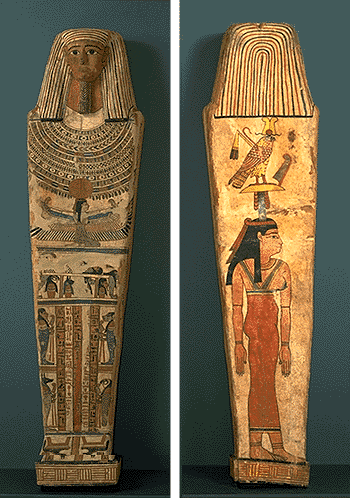
An elaborate funeral procession of priests, relatives, friends, servants, and professional mourners accompanied the mummy to the tomb. Attended by priests, the mummy, in its magnificent coffin, was carried on a great sledge pulled by oxen. The mourners followed behind the sledge. In the procession, too, were porters bearing gifts to be placed in the tomb. These mortuary accouterments believed essential for a happy afterlife might be furniture, weapons, jewelry, food, linens - any or all of those things that had made for comfort and happiness in the earthly life.
The final ceremony at the tomb was the opening of the mouth. Through this ceremony the mummy was thought to regain ability to move, to talk, and to eat. In order to fulfill his destiny in the afterworld. It was necessary that the priests perform this last rite which would restore to him the functions of a living person.
The mummy was then carried into the tomb and sealed in the outer coffin or sarcophagus. The Book of the Dead was placed near him, mortuary gifts were piled about, and priests in the guise of gods made sure no evil spirits lurked in the tomb.
According to Egyptian belief, interment of the mummy did not automatically insure entrance into the afterworld. The deceased had first to appear before a group of forty-two spiritual assessors and convince them that he had led a righteous life on earth. Then in a final trial before Osiris, king of the nether world, the heart of the deceased was placed on the Great Scales and balanced against a feather, symbol of righteous truth. Anubis, the jackal-headed god who presided over embalming, did the weighing, while Thoth, the ibis-headed scribe of the gods, recorded the result on a tablet. If the heart of the deceased passed this test, he was admitted into heaven. If not, his soul was doomed to roam the earth forever.
The Pre-Dynastic Egyptian (before 3000 n.e.) was buried in the sand and was surrounded with pottery jars containing food. He was placed on his side in a contracted position, and was occasionally wrapped in reed matting or animal hide. Later, the dead were placed in crudely made baskets, boxes, or pottery coffins, which were buried in the sand or deposited in small natural caves at the base of the cliffs in the Nile Valley. By 3000 b.c. men of importance had small chambers cut for themselves in the rock, often with a shallow pit or niche to receive the coffin. From these beginnings evolved the typical Egyptian tomb consisting of two essential parts: the burial chamber and a room in which offerings to the dead were placed.
Most impressive of all Egyptian tombs are those of the Pyramid Age (2800-2250 B.C.). Those colossal tombs that are as famous as Egypt herself developed from a less elaborate form now called "mastaba" (from the Arabic word mastabah, meaning "bench," which describes the form of the superstructure of the tomb). The mastaba tombs are low, rectangular structures of brick and stone built on bedrock. The building houses an offering chamber, or a series of them, and a secret room containing a statue of the deceased.
A vertical shaft in the superstructure leads down into the bedrock to the tomb chamber some twenty to eighty feet below. The limestone walls in the offering chambers of the mastaba tombs are covered with sculptured scenes done in low relief. They were originally painted, and some of the color still remains. It is from these skilfully executed scenes depicting contemporary Egyptian life that we derive much of our knowledge of the period. The mastaba tombs are for the most part those of nobles, the pharaohs preferring the more monumental pyramids. The great pyramids at Giza, tombs of the Fourth Dynasty kings, are by far the most imposing of the pyramid tombs.
The Egyptians were mummifying their dead even in the days of the pyramids. Indeed, there are mummies that antedate the pyramids. These ancient mummies are wrapped in the contracted position characteristic of Pre-Dynastic burials, whereas the mummy of the Pyramid Age lies full length on its back, enclosed in a box-type coffin decorated to resemble a house.
In the early days of mummification only the kings were definitely conceded the opportunity to attain an exalted afterlife. Religious texts to aid the dead kings in gaining entrance into heaven were carved on the stone walls of the mortuary chambers of some of the pyramids. These are now known as the Pyramid Texts. It is on the walls of the pyramids of the Fifth and Sixth Dynasty kings at Saqqara -smaller and less imposing pyramids than those at Giza - that these oldest collections of Egyptian religious texts are found. Although nobles of the Pyramid Age were also accorded sumptuous burial, no texts are found in their tombs.
By the time of the Middle Kingdom (2100-1780 b.c.), after the period of the mastabas and pyramids, tombs and their accessory chambers were usually hewn out of solid rock in the sides of the hills along the Nile. Occasionally, however, tombs were enclosed by or built under mortuary buildings erected on the plain.
These buildings served as chapels or offering chambers. The mummy of the Middle Kingdom was placed on its left side in a rectangular wooden coffin on which was painted religious texts. These Coffin Texts were excerpts from the older Pyramid Texts, with the addition of new thoughts and symbols. Some mummies had a cartonnage mask over the upper portion of the body. These cartonnage coverings--layers of linen or papyrus soaked in plaster - were shaped in human form and painted. Sometimes the entire mummy was enclosed in such a covering, a practice which quickly led to the making of coffins themselves in mummy form.
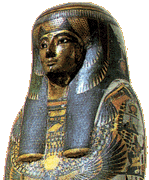
A person of rank or wealth (and these went hand in hand), would have a series of two or three coffins, each case fitting inside the other, with the inner one the most elaborate. Often the outer coffin would be carved from stone in mummy form, or would consist of a huge stone sarcophagus. It was late in this period, when liberalization of religious concepts extended the privilege of an afterlife to those in less fortunate circumstances than kings and nobles, that beards appeared on mummy cases. The beard, heretofore worn only by divinities and kings, indicated presumption on the part of the deceased that he would be accepted into their immortal presence.
During the time of the Eighteenth and Nineteenth Dynasties the rock-cut tombs reached their zenith in the famous Tombs of the Kings in the valleys at Thebes. These tombs consist of corridors, chambers, and halls descending into the solid rock of the hillsides a distance of several hundred feet. The walls are covered with religious texts and scenes, and with inscriptions and pictures portraying every phase in the life of the deceased, all beautifully painted.
Mummification practices, too, varied with the passing centuries. The use of the Canopic Jars as repositories was discontinued during the Twenty-first Dynasty (1085-945 BC), and the viscera were henceforth wrapped in packages and replaced in the body or bound with it. Hollows in the desiccated body were cleverly filled out by placing pads of linen underneath the skin. From this period on, the art of making good mummies went into a gradual decline, even though mummification continued to be practiced for another fifteen hundred years. Less attention came to be paid to the condition of the body itself, and more to the external appearance of the wrappings.
In Roman times (after 30 BC) a garish type of coffin came into use. Showy cartonnage coverings were formed and painted in fanciful likeness of the deceased. At the same time, coffin-makers were building coffins of simple board boxes. On the cover there might be a life-sized plaster face modeled after that of the dead. Sometimes a painted portrait of the deceased was placed inside the coffin over the face of the mummy.
Quite naturally, wealth was always a dominant actor in the mummification and burial accorded an individual. Although actual Egyptian records of the cost of mummi~cation are lacking, Diodorus Siculus, a Greek historian who traveled in Egypt, touches on burial costs in his writings. According to Diodorus, at the time he journeyed in Egypt (60-57 b.c.) there were three grades of burial. One was expensive, costing sixty-six pounds of silver (one talent), another cost a third as much (twenty minas), and the lowest grade of burial cost much less.
Tombs for the common people had no chambers. The coffins were placed in walled recesses in the side of a rock or in shallow holes gouged out of the rocky plain. Mummies of the poor were placed in common repositories, either with or without coffins. The bodies of those with no money at all were given a perfunctory ceremonial cleansing, were sometimes covered with a cloth, and were buried in the sand.
The Egyptians believed that a god incarnate assumed the form of an animal. Nearly every deity was associated in their minds with a certain bird or beast. So it is not surprising that we find near the sites of ancient cities large cemeteries devoted to the burial of animals. Usually only one kind of animal was buried in a given cemetery. Adjacent to each such cemetery was a temple devoted to the cult of the god identified with the specific kind of animal buried at that place.
The animals were mummified, but not always too carefully. Chief stress was laid on the bandaging, the object having been that the package should clearly indicate the kind of animal enclosed. Often these animal mummies were placed in theriomorphic coffins. There are mummies of jackals, cats, ibises, snakes, lizards, gazelles, hawks, bulls, sheep, baboons, crocodiles--in fact, almost every conceivable kind of animal known to Egypt.
At some places animal tombs such as those of the Apis bulls at Memphis are found. The tombs of the Apis bulls, which date from the Eighteenth Dynasty and later, consist of subterranean passages and vaults hewn in the rock an aggregate length of some twelve hundred feet. Many of the bulls were placed in huge stone sarcophagi.
The ambition of every Egyptian was to have a well mummified body and a perpetually cared-for tomb. The children of the deceased were charged with the maintenance of this home on earth and the observation of all attendant ceremonies. In the case of a favored government official a portion of the state revenue might be assigned as an endowment for the care of the tomb.
As the number of deceased ancestors and officials multiplied, however, and the consequent cost of tomb maintenance became excessive, the tendency was to neglect those of the remote past and to concentrate attention on those of the more recently deceased. Thus the living inhabitant of ancient Egypt, with all the faith he placed in the preservation of his own mummy, was constantly faced with the anomaly of neglected and despoiled tombs -for tomb robbers were at work even during the days of mummification.
We have Egyptian papyri recording the robbery of royal tombs and the capture and punishment of the despoilers. An archaeologist rarely finds a tomb that has not been plundered.
'Mummy dust' was sometimes stolen from the Sarcophagi and sold.
There are about 500 Egyptian mummies in the US. Most are in museums. Some are privately owned.
In the Middle Ages, based on a mis-translation from Arabic it became common practice to grind mummies preserved in bitumen into a powder to be sold and used as medicine. When actual mummies became unavailable, the sun-desiccated corpses of criminals, slaves and suicidal people were substituted by mendacious merchants. The practice developed into a wide-scale business which flourished until the late 16th century. Two centuries ago, mummies were still believed to have medicinal properties against bleeding, and were sold as pharmaceuticals in powdered form as in Mellified Man.
Artists also made use of Egyptian mummies; the brownish paint known as Caput mortuum (Latin for death's head) was originally made from the wrappings of mummies. It was most popular in the 17th century but was discontinued in the early 19th century when its composition became generally known to artists.
In the 19th century, European aristocrats would occasionally entertain themselves by purchasing mummies, having them unwrapped, and holding observation sessions. These sessions destroyed hundreds of mummies, because the exposure to the air caused them to disintegrate.
An urban myth of mummies being used as fuel for locomotives was popularized by Mark Twain, but the truth of the story remains a debate.
During the American Civil War, mummy-wrapping linens were said to have been used to manufacture paper. Evidence for the reality of these claims is still equivocal.
Many thousands of mummified cats were sent from Egypt to England to be processed for use in fertilizer.
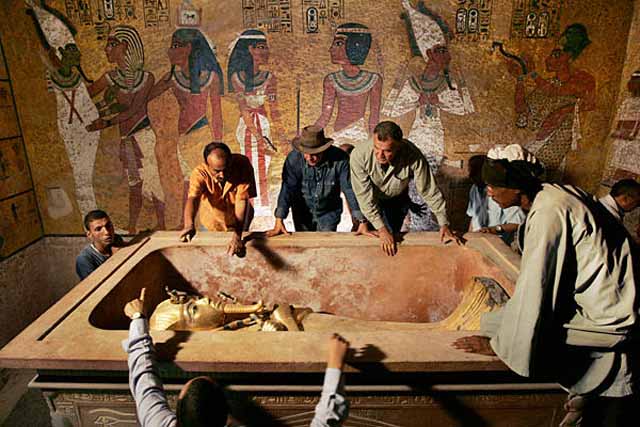
King Tutankhamen

Thutmose II's mummy was discovered in the Deir el-Bahri cache, revealed in 1881. He was interred along with other 18th and 19th dynasty leaders including Ahmose I, Amenhotep I, Thutmose I, Thutmose III, Ramesses I, Seti I, Ramesses II, and Ramesses IX.
The mummy was unwrapped by Gaston Maspero on July 1, 1886. There is a strong familial resemblance to the mummy of Thutmose I, his likely father, as the mummy face and shape of the head are very similar. The body of Thutmose II suffered greatly at the hands of ancient tomb robbers, with his left arm broken off at the shoulder-joint, the forearm separated at the elbow joint, and his right arm chopped off below the elbow. His anterior abdominal wall and much of his chest had been hacked at, possibly by an axe. In addition, his right leg had been severed from his body.[29] All of these injuries were sustained post-mortem, though the body also showed signs that Thutmose II did not have an easy life
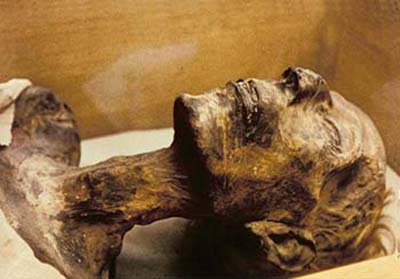
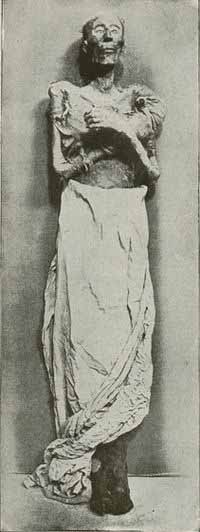
Ramesses II was originally buried in the tomb KV7 in the Valley of the Kings but, because of looting, priests later transferred the body to a holding area, re-wrapped it, and placed it inside the tomb of queen Inhapy. Seventy-two hours later it was again moved, to the tomb of the high priest Pinudjem II. All of this is recorded in hieroglyphics on the linen covering the body. His mummy is today in Cairo's Egyptian Museum. The pharaoh's mummy reveals an aquiline nose and strong jaw, and stands at some 1.7 metres (5 ft 7 in).[58] His ultimate successor was his thirteenth son, Merneptah.
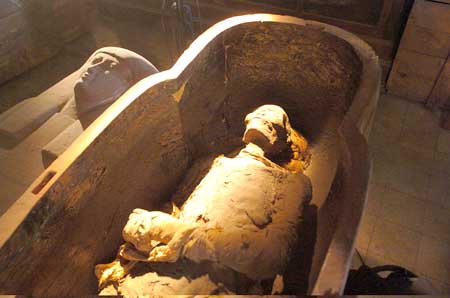
In the Royal Mummy Cache at DB320, an ivory canopic coffer was found that was inscribed with the name of Hatshepsut and contained a mummified liver or spleen as well as the tooth that now has been found to fit the second mummy in the wet nurse's tomb. There was a royal lady of the twenty-first dynasty of the same name, however, and for a while it was thought possible that it could have belonged to her instead
The Gebelein predynastic mummies are six naturally mummified bodies, dating to approximately 3400 BC from the Late Predynastic period of Egypt, and were the first complete pre-dynastic bodies to be discovered. The well-preserved bodies were excavated at the end of the nineteenth century by Wallis Budge, the British Museum Keeper for Egyptology, from shallow sand graves near Gebelein (modern name Naga el-Gherira) in the Egyptian desert.
Budge excavated all the bodies from the same grave site. Two were identified as male and one as female, with the others being of undetermined gender. The bodies were given to the British Museum in 1900. Some grave-goods were documented at the time of excavation as "pots and flints", however they were not passed on to the British Museum and their whereabouts remain unknown. Three of the bodies were found with coverings of different types (reed matting, palm fibre and an animal skin), which still remain with the bodies. The bodies were found in foetal positions lying on their left sides.
From 1901 the first body excavated has remained on display in the British Museum. This body was originally nicknamed 'Ginger' due to his red hair; this nickname is no longer officially used as part of recent ethical policies for human remains.
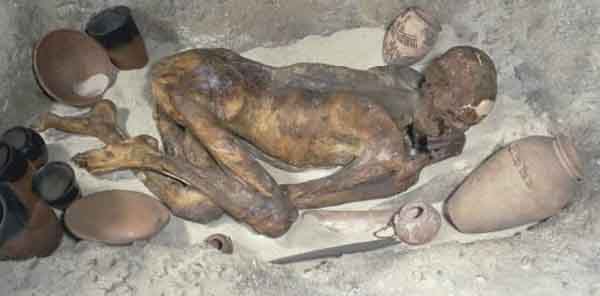
Currently on display in the British Museum, Ginger was discovered buried in hot desert sand. Desert conditions can naturally preserve bodies so it is uncertain whether the mummification was intentional or not. However, since Ginger was buried with some pottery vessels it is likely that the mummification was a result of preservation techniques of those burying him. Stones might have been piled on top to prevent the corpse from being eaten by jackals and other scavengers and the pottery might have held food and drink which was later believed to sustain the deceased during the journey to the other world. While there are no written records of religion from that time, the beliefs of those who buried Ginger could have resembled the later religion to some extent.
The earliest technique of deliberate mummification, as used ca. 3000 BC, was minimal and not yet mastered. The organs were eventually removed (with the exception of the heart) and stored in canopic jars, allowing the body to be more well-preserved as it rested. Occasionally embalmers would break the bone behind the nose, and break the brain into small pieces in order that it could be pulled out through the nasal passage. The embalmers would then fill the skull with thick plant-based resin or plant resin sawdust.
It also wasnÕt until the Middle Kingdom that embalmers used natural salts to remove moisture from the body. The salt-like substance natron dried out and preserved more flesh than bone. Once dried, mummies were ritualistically anointed with oils and perfumes. The 21st Dynasty brought forth its most advanced skills in embalming and the mummification process reached its peak.
The bodies' abdomens were opened and all organs, except for the heart, were removed and preserved in Canopic jars. The brain, thought to be useless, was pulled out through the nose with hooks, then discarded. It was also drained through the nose after being liquefied with the same hooks.
The emptied body was then covered in natron, to speed up the process of dehydration and prevent decomposition. Natron dries the body up faster than desert sand, preserving the body better. Often finger and toe protectors were placed over the mummies fingers and toes to prevent breakage. They were wrapped with strips of white linen that protected the body from being damaged. After that, they were wrapped in a sheet of canvas to further protect them. Many sacred charms and amulets were placed in and around the mummy and the wrappings. This was meant to protect the mummy from harm and to give good luck to the Ka of the mummy. Once preserved, the mummies were laid to rest in a sarcophagus inside a tomb, where it was believed that the mummy would rest eternally. In some cases the mummy's mouth would later be opened in a ritual designed to symbolize breathing, giving rise to legends about revivified mummies.
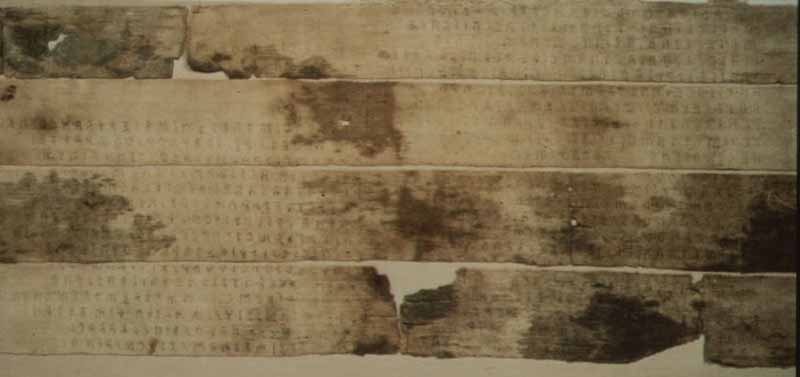
Liber Linteus is the longest Etruscan text and the only extant linen book, dated to the 3rd century BC. It remains mostly untranslated because of the lack of knowledge about the Etruscan language, though the few words which can be understood indicate that the text is most likely a ritual calendar. The fabric of the book was preserved when it was used for mummy wrappings in Ptolemaic Egypt. The mummy was bought in Alexandria in 1848 and since 1867 both the mummy and the manuscript have been kept in Zagreb, Croatia, now in a refrigerated room at the Archaeological Museum.
Mummies Reveal Egyptians Styled Hair with 'Product' Live Science - August 30, 2011
Ancient Egyptians might have been just as vain as humans today. They seem to have styled their hair with fat-based products to enhance their appearance and accentuate their individuality, new research suggests.
Egyptian Princess Mummy Had Oldest Known Heart Disease National Geographic - April 15, 2011
An ancient Egyptian princess might have been able to postpone her mummification if she had cut the calories and exercised more, medical experts say. Known as Ahmose Meryet Amon, the princess lived some 3,500 years ago and died in her 40s. She was entombed at the Deir el-Bahri royal mortuary temple on the west bank of the Nile, opposite to the city of Luxor. The princess's mummified body is among those now housed at the Egyptian Museum in Cairo.
Nubian Mummies Had 'Modern' Disease Live Science - June 9, 2011
A "modern" disease of humans may have been what sickened ancient Nubian cultures, research on more than 200 mummies has found. The mummies were infected by a parasitic worm associated with irrigation ditches.The disease, called schistosomiasis, is contracted through the skin when a person comes into contact with worm-infested waters. The disease infects over 200 million people worldwide a year; once contracted, the disease causes a rash, followed by fever, chills, cough and muscle aches. If infection goes untreated, it can damage the liver, intestines, lungs and bladder.
Ancient Mummy's Face Recreated Live Science - June 24, 2009
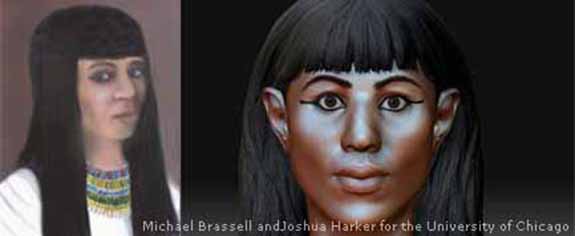
Cold Case Techniques Bring MummyÕs Face To 'Life' Science Daily - June 23, 2009
Thanks to the skills of artists who work on cold case investigations, people have a chance to see what the University of ChicagoÕs mummy Meresamun may have looked like in real life.
Dozens of Mummies Found in Rock Tombs National Geographic - April 15, 2009

Oldest Malarial Mummies Shed Light on Disease Evolution National Geographic - October 30, 2008
The oldest known cases of malaria have been discovered in two 3,500-year-old Egyptian mummies, scientists announced. Researchers in Germany studied bone tissue samples from more than 90 mummies found in the ancient Egyptian city of Thebes, now called Luxor.
Nubian Mummies Had 'Modern' Disease Live Science - June 9, 2011
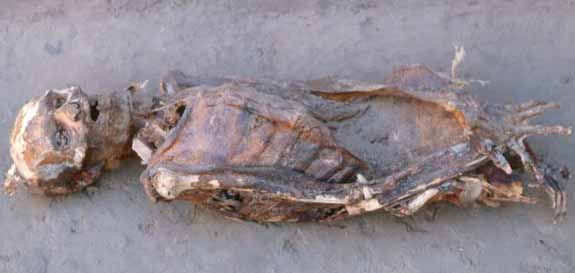
A "modern" disease of humans may have been what sickened ancient Nubian cultures, research on more than 200 mummies has found. The mummies were infected by a parasitic worm associated with irrigation ditches.The disease, called schistosomiasis, is contracted through the skin when a person comes into contact with worm-infested waters. The disease infects over 200 million people worldwide a year; once contracted, the disease causes a rash, followed by fever, chills, cough and muscle aches. If infection goes untreated, it can damage the liver, intestines, lungs and bladder.